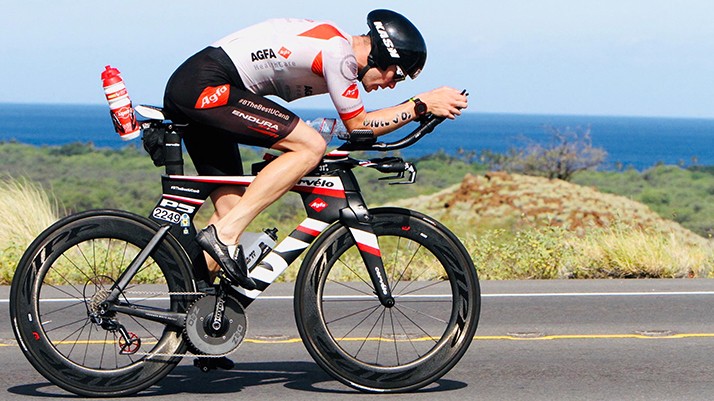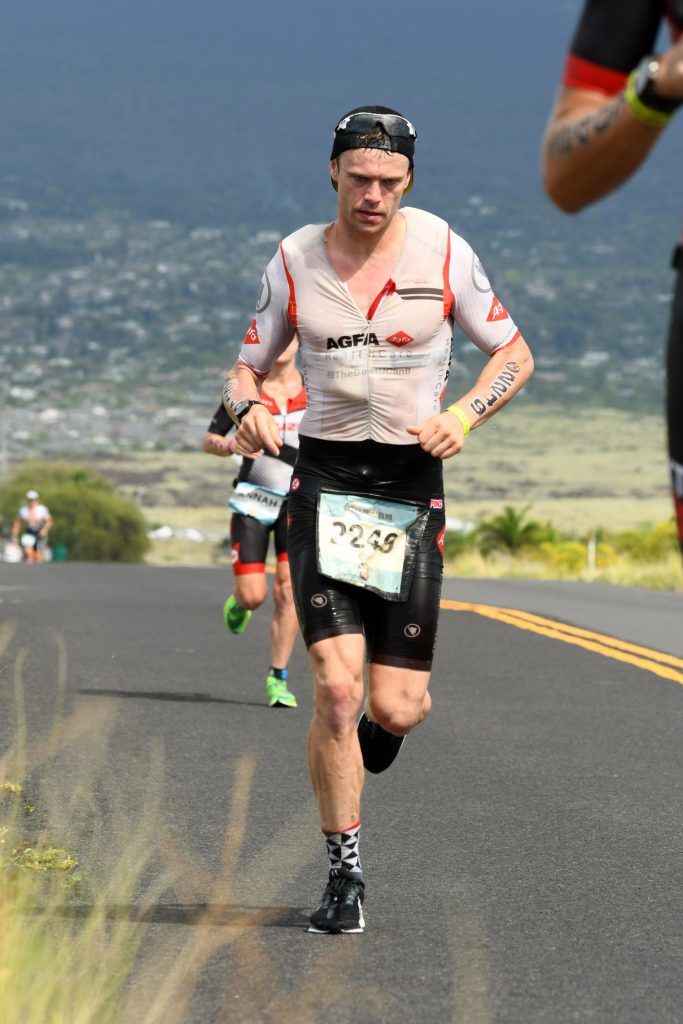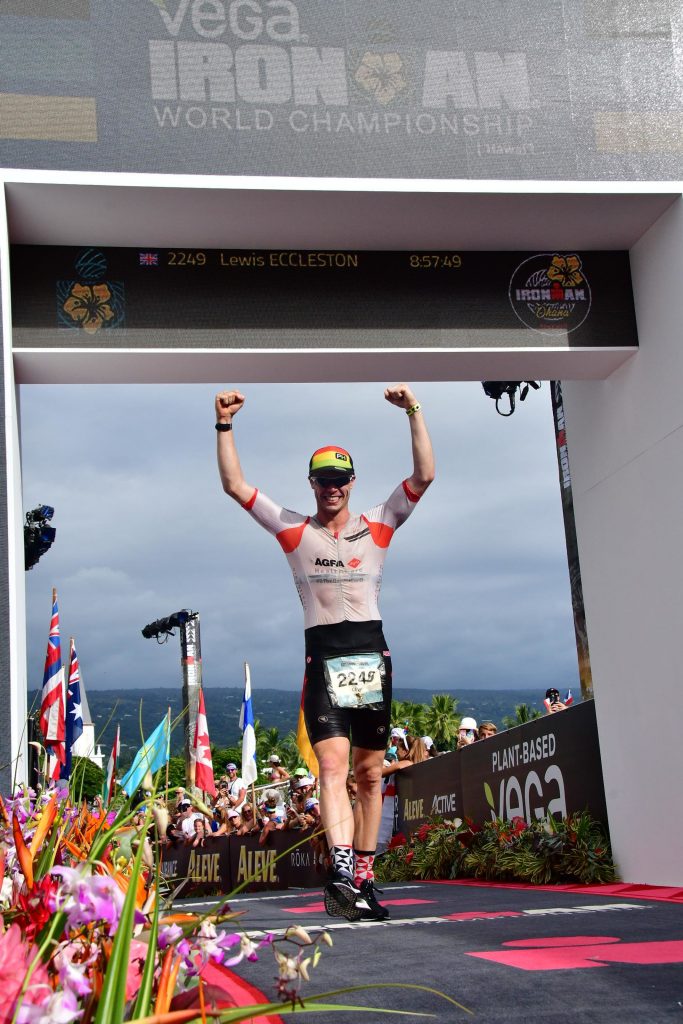12 months in the making – 3rd in age Group and 45mins faster than in 2017.
Post 2019 Ironman World Championship, we caught up with #BTheBestUCanB Agfa sponsored amateur athlete Lewis Eccleston.
The race’s background
The inaugural Kona Ironman race was held in 1978 to challenge athletes who had seen success at endurance swimming and running events. Honolulu-based Navy couple Judy and John Collins proposed combining the three toughest endurance races in Hawaii – the 2.4-mile Waikiki Roughwater Swim, 112 miles of the Around-O’ahu Bike Race and the 26.2-mile Honolulu Marathon – into one event. In 1981, the race moved to the barren lava fields of Kona on the Big Island of Hawaii. On October 12th 2019, over 2,000 athletes embarked on a 140.6-mile journey that presents the ultimate test of body, mind and spirit.
Campaign Kona 2019
Lewis’ 2019 Ironman World Championships campaign started with qualifying at Ironman Wales in September 2018. This enabled Lewis maximum time to focus on the end goal, Kona 2019.
After 12 months of training early mornings, late evenings and weekends the time had come at 6.25am Hawaii-Aleutian Time Zone on 12 October 2019. Competing at the highest level whilst also having a full-time career is a huge challenge and the ‘Weekend Warriors’ at the Ironman World Championships are treated with the highest respect. The race is the ultimate test of endurance given the many variables outside the athletes’ control. This is demonstrated each year with many of the professional athletes, who may not be having their best races, continuing to the finish line respecting both the race and the dedication of other competitors.
The Race
Conditions were far from easy right from the start in Kailua Bay with a large swell meaning swim conditions were very choppy and after nearly an hour in the water, some athletes do suffer from motion sickness. No such issues for Lewis who completed the 2.4-mile swim in 58:55, maybe a little bit slower than the practice swim due to the conditions and the fact that the wave starts which meant there was a lack of athlete ‘packs’ to draft off.
Transition One from swim to bike was very busy and the knock-on effect was that for the first hour on the bike Lewis held slightly back carefully watching out for drafting violations when athletes can easily get caught out. Athletes must have a draft zone distance from the front wheel of the leading athlete to the front wheel of the following athlete; roughly equal to six bike lengths of clear space between athletes. The time allowed to pass another athlete is 25 seconds. This means that athletes do not get an unfair aerodynamic advantage from the athlete in front.
Lewis’ strategy was to try and get his heart rate down straight away and, using his previous experience at Kona, he held back quite a bit knowing it pays off in the second half of the bike leg. Lewis picked his moments on the bike when he could put the power down, for example when the temperature dropped, or the wind changed direction or when his heart rate dropped. Lewis knew he had to make the most of the opportunities as it can be easy to sit behind a group of people. For his age group wave start Lewis was in the front pack of swimmers, so despite the course being busy he did not have to overtake too many other athletes. The wind however changes direction so quickly, so it can go from tail wind to head wind and then it blows every direction. Lewis kept watching the people in front and how the wind was affecting them to get an idea of how it was going to affect him. On the bike Lewis decided that at certain times he was going to have to dig deep and go into the red, maximising any advantage.
At the bike turn around Lewis knew he was high up in his age group race and had further confirmation at the end of the bike that he was 7th. Heading out on the run Lewis was also made aware of his position with people telling him and how far ahead the next athletes were in front. At the turn around on the run, Lewis was aware that he was within a few minutes of top 5 position, so he just kept going and picking people off one by one. Within a further 3 or 4 miles he was in 3rd place but looking at his heart rate and pace he realised he had to hold back a bit at that point and be patient, otherwise he would have simply blown up. Lewis remained patient on the run pushing hard where he could but staying right on the limit as the competition was so tough with minutes separating the top athletes. Lewis also knew he could not go into the red too much. They say athletes have 10 matches to burn in Ironman, so he was careful when to burn them.
The last 10 kilometres of the run were extremely tough, Lewis was still 3rd in his age group and less than a minute behind 2nd. Lewis had put everything into the race and taken the opportunities where he could. With 2 kilometres to go at the top of the final hill both hamstrings cramped, so Lewis knew he was running at his limit and could not push any more. He had nothing left. A quick stop to re-focus and reset the commitment and drive that had been his focus for the last 12 months pushed Lewis forward. He was not quite sure how he ran the last kilometre and he was sure he must have looked very strange to the watching crowds, but he did it. Lewis finished 3rd in his 25-29 age group and 19th amateur overall, in a time of 8:57 (Swim 58:55, Bike 4:44, Run 3:08). An incredible achievement against a very tough field of athletes, on a really tough day, weather wise.
Its incredible to say that Lewis is a top 20 finisher at the Ironman World Championship, the ultimate test of body, mind and spirit. Top twenty in the world remembering that Lewis was at the front of his ‘amateur’ age group race. What is even more amazing is that from the last time Lewis raced at Kona in 2017, he took so much experience away from the race and built on that over the last two years to improve his finish time by a massive 45 minutes.
As his achievement starts to sink in Lewis commented, “I couldn’t be happier with my result. I said before the race that one of my main objectives from the performance was to get a result to justify the all the work that has gone into the race, not just on a personal level but for everyone involved. Job done.”
The future
Lewis is taking some well-earned downtime for a few weeks and enjoying his achievement. He keeps enjoying Ironman and training hard, which may seem strange to some people, but he genuinely does. After a break Lewis will then sit down with his coach Paul Savage to discuss and plan where and what next. Watch this space!



